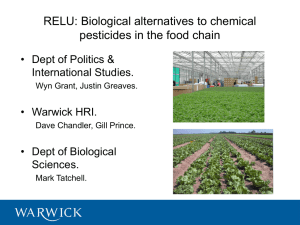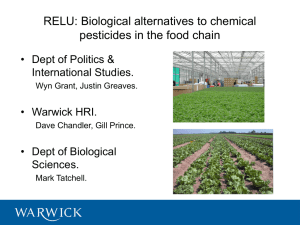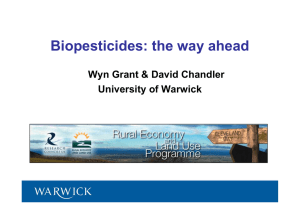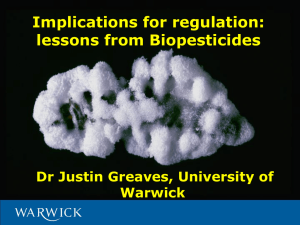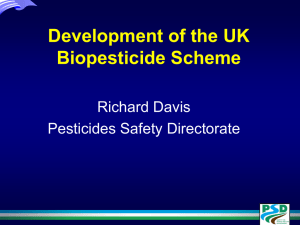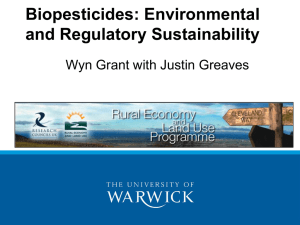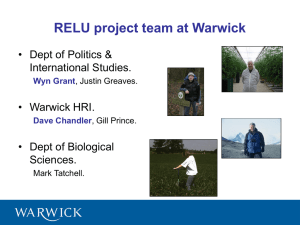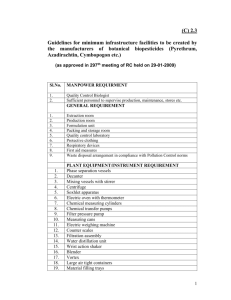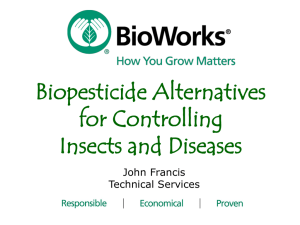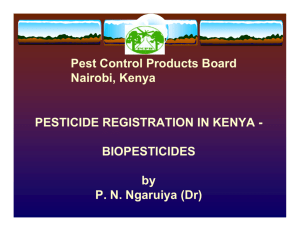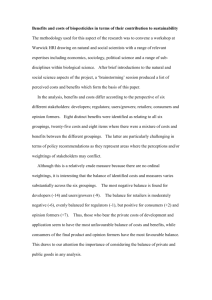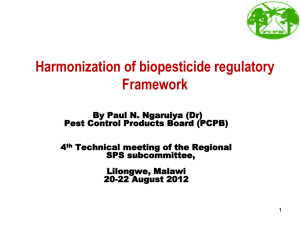Biopesticides, regulatory innovation & the regulatory state Dr Justin Greaves, University of Warwick
advertisement
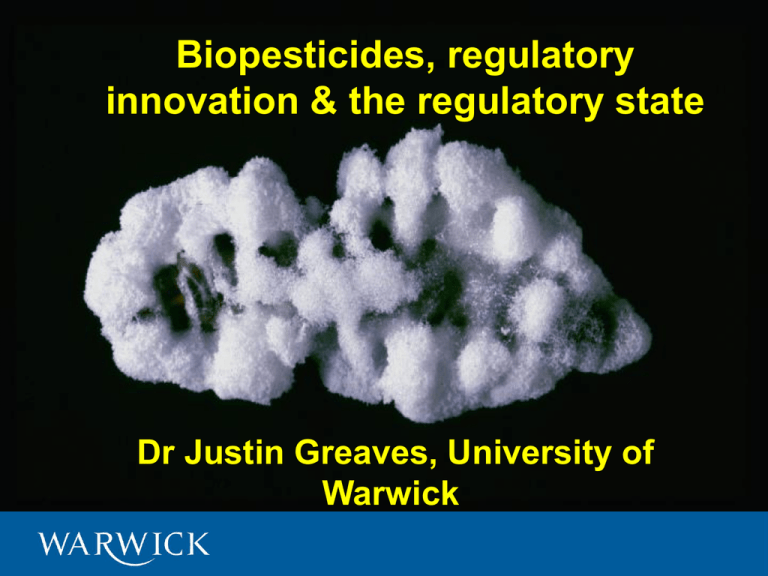
Biopesticides, regulatory innovation & the regulatory state Dr Justin Greaves, University of Warwick Introduction • Bureaucrats are (understandably) risk averse. This does not create an encouraging environment for regulatory innovation. • This presentation considers the possibility of regulatory innovation in the area of pesticides. • It looks, in particular, at how the Pesticides Safety Directorate (PSD) can be encouraged to innovate, particularly in the area of biopesticides. What are biopesticides? • Biopesticides are mass produced biologically based agents used for the control of plant pests. They include: - Living Organisms (natural enemies) invertebrates, nematodes and micro-organisms - Naturally Occurring substances plant abstracts; Semiochemicals (eg: insect pheromones) - Genes (USA) Plant Incorporated Products Levels of analysis • At the outset, a ‘levels of analysis’ problem. • Macro level or grand theory: the debate about Weberian bureaucratic theory. • Middle-range theory: ‘The Regulatory State’ (Moran) and work on innovation by Downs et al. • Micro level analysis : the role of PSD and ACP in their approach towards biopesticides. Bureaucratic theory • Systems of regulation can have unintended consequences. Bureaucratic theory points to a tendency for mechanisms to displace goals, for processes to become more important than outcomes. There may be consideration of policy instruments in isolation from their wider effects. • There could also be budget maximisation effects (see, Niskanen, 1971). Moran: the Regulatory State • Displacement of ‘command’ state (‘Keynesian welfare’ state) by regulatory state. • Involves more indirect forms of state control (which do not, however, necessarily reduce state power). • See in ideal typical terms as progressive. Replacement of self-regulation which was seen to fail both in terms of economic efficiency and public accountability. What is Regulatory Innovation? • Part of the ‘reinventing government’ debate. • It is important to distinguish between ‘change’ and ‘innovation’. • Regulatory innovation is innovation in any aspect of the regulatory system or regulatory regime (Black, 2005). Forces of Inertia and Change • Policy network theory: policy networks are good at managing incremental change, but tend only to innovate in conditions of crisis and exogenous shock. • Bureaucracies have to cope with considerable forces of inertia but there are also forces of change (see Downs 1967). • Downs points to three forces of change: the desire to do a good job, aggrandizement, and self defence against pressure from external agents. RELU PROJECT AT WARWICK • Dept of Politics & International Studies. Wyn Grant, Justin Greaves. • Warwick HRI. Dave Chandler, Gill Prince. • Dept of Biological Sciences. Mark Tatchell. Background to our research • Consumers are concerned about the health effects of pesticide residues on food. This concern is picked up by retailers who often push for pesticide reductions more rigorous than those required by regulators. • Alternative methods are required in order to develop systems of crop protection which are sustainable. • Reduced availability of substances/problems of pesticide resistance. Warwick Project Objectives (1) Main aims: – Assess limitations of chemical pesticide regulatory system for biopesticides. – Compare public policies on pesticide reduction. 16 New a.i. registrations – Identify processes that may sustain regulatory innovation. 14 12 conventional biological reduced risk conventional 10 8 6 4 2 0 Registration in the USA 1986 1988 1990 1992 1994 1996 1998 2000 2002 2004 2006 Warwick Project Objectives (2) Main aims: – Understand the effect of habitat type (e.g, woodland v. arable) on biodiversity of natural populations of insect pathogenic fungi. – Fungal life history: how do insect pathogenic fungi survive in soils? – Impact of spraying on indigenous fungal populations. Microbial biopesticides • The project is concerned with microbial bioinsecticides, based on entomopathogens, for the control of insect pests. • These exhibit desirable biologically-based properties (eg: specificity, reproductive potential, low impact on non-toxic residues, compatibility with other natural enemies, limited toxic residue). • However, they could have unwanted indirect effects (eg: on naturally occurring microbial agents occupying the same niche). Regulatory failure & biopesticides • Microbial biopesticides have been commercially available for over twenty years but represent less than 1% of the global market (90% of world sales = BT). • ‘Market failure’ hypothesis; market size is too small to provide economies of scale and encourage firms to enter (RELU project at Imperial College, Wye). • Regulatory failure hypothesis (Warwick): systematic problems arising in regulation along with specific problems (the use of a chemical pesticide driven regulatory model by PSD). Some problems with the regulatory system • The pilot scheme has resulted in a reduced registration fee for biopesticides but arguably it is still too high. • The big cost is the testing required to meet registration requirements. • The United States EPA tests for safety but not efficacy. One option, therefore, would be to reduce efficacy testing in the EU. How do the levels of analysis link up with the project? • Under the chemical pesticides regulatory model, specific and short-term goals may prevail over long-term aims of environmental protection and social benefits. • “Our analysis is influenced, at least as a point of departure, by models of the regulatory state” (Grant, 2005). • The key link is with the regulatory innovation literature. The barriers to innovation • Regulatory innovation may not be helped by the relatively weak policy network for biopesticides. • The biopesticides industry is small, largely made up of SMEs, still undergoing organisational development, and does not have the policy resources of the agrochemical industry. • PSD has to operate in a general climate in which regulatory innovation has been impeded by events such as BSE. Pressures for change (1) • Defra wants to encourage use of biopesticides for sustainability goals. Given slow progress, the core executive intervened. • The Cabinet Office approached PSD resulting in a new Biopesticides scheme. • Exogenous pressure has worked alongside an endogenous steer from within the policy side of PSD. This has been picked up by some on the approvals side. • PSD could go further and have a separate biopesticides unit (as in the US). A unit or mission could help PSD to innovate. Pressures for change (2) • Systematic reviews of provision (eg: Hampton Review). • UK Treasury concerns about the cost & powers of regulators could encourage ‘a lighter regulatory touch’ for biopesticides. • The Royal Commission on Environmental Protection (RCEP) report on Crop Spraying (2005) recommended that responsibility for pesticides policy be separate from the approval of pesticides. • Implications of REACH (new chemicals agency?) Conclusions • Risk averseness helps explain why biopesticides have not been used more. • Whilst some progress has been made, substantial innovation is still required. • Regulatory Innovation for biopesticides requires exogenous and endogenous pressure. • We aim to draw up design principles for a regulatory system that better facilitates the use of environmentally friendly pest control agents. Directed at decision-makers & it will hopefully stimulate reform. Please visit our website : http://www2.warwick.ac.uk/fac/soc/pais/bi opesticides Acknowledgements: Prof Wyn Grant Prof Mark Tatchell Dr David Chandler Gillian Prince (University of Warwick)
